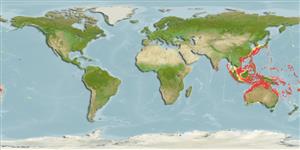分类 / Names
俗名 | 同种异名 | Catalog of Fishes(属, 种) | ITIS | CoL | WoRMS | Cloffa
Teleostei >
Pleuronectiformes (Flatfishes)
鰈目 (Flatfishes) >
Bothidae (Lefteye flounders)
Etymology: Arnoglossus: Greek, aros, -oy = lamb + Greek, glossa = tongue (Ref. 45335).
More on author: Günther.
Environment: milieu / climate zone / 深度上下限 / distribution range
生态学
海洋 居于水底的; 深度上下限 4 - 390 m (Ref. 9824). 热带
Eastern Indian Ocean and Western Pacific: Bay of Bengal to southern Japan, Taiwan, New Caledonia, and several areas of the Indo-Australian Archipelago (Ref. 9824).
东印度洋与西太平洋: 孟加拉国湾到日本南部,台湾,新加勒多尼亚与印澳群岛的一些区域.(参考文献 9824)
大小 / 重量 / 年龄
成熟度: Lm ? range ? - ? cm
Max length : 24.0 cm TL 雄鱼/尚未辨别雌雄; (Ref. 9824)
背棘 (总数) : 0; 背的软条 (总数) : 100 - 114; 臀棘: 0; 臀鳍软条: 78 - 91. Mouth rather small, contained2. to 2.6 times in head length, maxillary extending to below the anterior margin or anterior 1/3 of lower eye. Gill rakers present on upper limb. Caudal fin with 2 simple rays on upper and lower margins. In the male, several anterior dorsal rays somewhat elongated.
Body shape (shape guide): short and / or deep; Cross section: compressed.
嘴相当小, 包含了 2. 到 2.6 倍头长, 在前缘或眼睛下部的前 1/3 之下上颌骨延伸至。 有鳃耙在上边缘上。 在上、下边缘上尾鳍有 2个单一的鳍条。 在雄鱼中,一些前面的背鳍鳍条略微延长了。
Inhabits sandy substrates in coastal bays to deep offshore (Ref. 48637). Feeds on benthic animals.
在近岸海湾到外海深处中栖息于沙的底部。 (参考文献 48637) 吃底栖的动物。
Life cycle and mating behavior
成熟度 | 繁殖 | 产卵场 | 卵 | 孕卵数 | 仔鱼
东印度洋与西太平洋: 孟加拉国湾到日本南部,台湾,新加勒多尼亚与印澳群岛的一些区域.(参考文献 9824)
Masuda, H., K. Amaoka, C. Araga, T. Uyeno and T. Yoshino, 1984. The fishes of the Japanese Archipelago. Vol. 1. Tokai University Press, Tokyo, Japan. 437 p. (text). (Ref. 559)
世界自然保护联盟红皮书 (Ref. 130435: Version 2025-1)
人类利用
渔业: 没有兴趣
工具
特别资料
下载 XML
网络资源
Estimates based on models
Preferred temperature (参考文献
123201): 16.4 - 27.8, mean 23.6 °C (based on 607 cells).
Phylogenetic diversity index (参考文献
82804): PD
50 = 0.5000 [Uniqueness, from 0.5 = low to 2.0 = high].
Bayesian length-weight: a=0.00912 (0.00408 - 0.02036), b=3.04 (2.85 - 3.23), in cm total length, based on LWR estimates for this (Sub)family-body shape (Ref.
93245).
营养阶层 (参考文献
69278): 3.5 ±0.37 se; based on food items.
回复力 (参考文献
120179): 中等的, 族群倍增时间最少 1.4 - 4.4年 (Preliminary K or Fecundity.).
Fishing Vulnerability (Ref.
59153): Low vulnerability (14 of 100).
🛈
